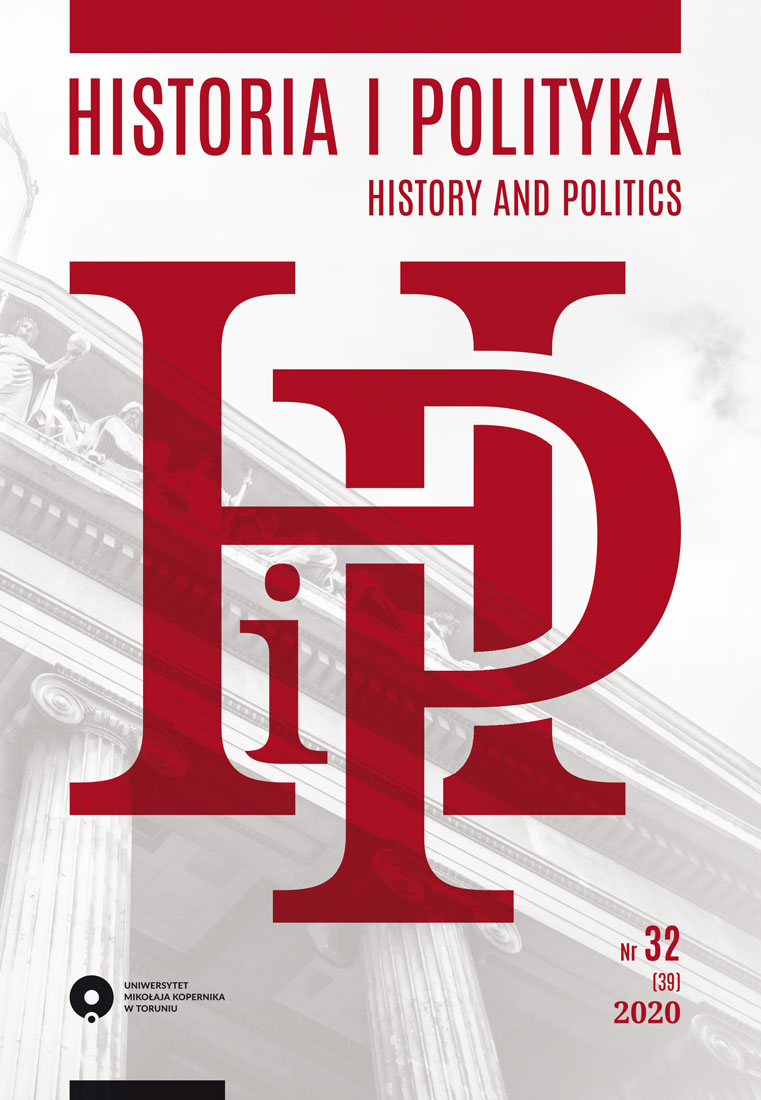Methodological Framework of Contemporary Propaganda in the Case of Post-Soviet Countries of the Caspian Sea Region
DOI:
https://doi.org/10.12775/HiP.2020.020Słowa kluczowe
Russia, Kazakhstan, persuasion, trolling, TurkmenistanAbstrakt
Development of social media creates possibility for governments of easy access to society. Oil and gas resources in post-Soviet countries of the Caspian Sea region make this region the focal point of propaganda campaigns. Therefore, the main aim of the paper is to create a map of contemporary propaganda by investigating its characteristics, tools, types and strategies as well as limitations, and applying it to the post-Soviet countries of the Caspian Sea region. The main definition of propaganda is investigated with theoretical analysis method. In the empirical part, the paper analyzes disinformation, fake news, trolls, and videos as propaganda strategy of governments in the case of post-Soviet countries of the Caspian Sea region. Qualitative content analysis is useful to investigate news, texts, videos, and images shared on social media. Descriptive analysis is set up to research multiplicity of propaganda campaigns in the mentioned region. Structured interview method will be used with propaganda experts to analyze their opinion on contemporary propaganda and persuasion.
To summarize, propaganda campaigns are more persuasive according to new technologies. There is no doubt that its working principles will evolve as time goes on. This paper investigates the working principles of contemporary propaganda in the case of post-Soviet countries of the Caspian Sea region. Thus, this work is hoped to create a framework for further analysis of the methodology of contemporary propaganda.
Bibliografia
Begg, I.M., Anas, A., & Farinacci, S. (1992). Dissociation of Processes in Belief: Source Recollection, Statement Familiarity, and the Illusion of Truth. Journal of Experimental Psychology: General, 121(4), 446–458. DOI: 10.1037/0096-3445.121.4.446.
Bradshaw, S., & Howard, P. (2017). Troops, Trolls and Troublemakers: A Global Inventory of Organized Social Media Manipulation. Retrieved from: https://ora.ox.ac.uk/objects/uuid:cef7e8d9-27bf-4ea5-9fd6-855209b3e1f6.
De Paoli, S. (2016). The Raise of the Robots in Virtual Worlds: A Comparison and a Framework for Investigating Bots in Social Networks Sites and MMOGs. In: Y. Sivan (ed.). Handbook on 3D3C Platforms (pp. 59–83). Switzerland: Springer, Cham. Retrieved from: https://link.springer.com/chapter/10.1007/978-3-319-22041-3_2.
DeSteno, D., Petty, R.E., Rucker, D.D., Wegener, D.T., & Braverman, J. (2004). Discrete Emotions and Persuasion: The Role of Emotion-Induced Expectancies. Journal of Personality and Social Psychology, 86(1), 43–56. DOI: 10.1037/0022-3514.86.1.43.
Fletcher, R., Cornia, A., Graves, L., & Nielsen, R.K. (2018). Measuring the Reach of “Fake News” and Online Disinformation in Europe. Retrieved from: https://www.press.is/static/files/frettamyndir/reuterfake.pdf.
Hasher, L., Goldstein, D., & Toppino, T. (1977). Frequency and the Conference of Referential Validity. Journal of Verbal Learning and Verbal Behavior, 16(1), 107–112. DOI: 10.1016/S0022-5371(77)80012-1.
Heredia, B., Prusa, J.D., & Khoshgoftaar, T.M. (2018, October). The Impact of Malicious Accounts on Political Tweet Sentiment. In: 2018 IEEE 4th International Conference on Collaboration and Internet Computing (CIC) (pp. 197–202). Philadelphia, PA: IEEE. DOI: 10.1109/CIC.2018.00035.
Hindman, M., & Barash, V. (2018). Disinformation, ‘Fake News’ and Influence Campaigns on Twitter. Miami, FL: Knight Foundation. Retrieved from: https://www.issuelab.org/resources/33163/33163.pdf.
Lasswell, H.D. (1927). The Theory of Political Propaganda. American Political Science Review, 21(3), 627–631. DOI: https://doi.org/10.2307/1945515.
Marwick, A., & Lewis, R. (2017). Media Manipulation and Disinformation Online. New York: Data & Society Research Institute. :
McCroskey, J.C., & Young, T.J. (1981). Ethos and Credibility: The Construct and Its Measurement after Three Decades. Communication Studies, 32(1), 24–34. DOI: 10.1080/10510978109368075.
Paul, C., & Matthews, M. (2016). The Russian “Firehose of Falsehood” Propaganda Model. Rand Corporation, 2(7), 1–10.
Petty, R.E., Cacioppo, J.T., Strathman, A.J., & Priester, J.R. (2005). To Think or Not to Think: Exploring Two Routes to Persuasion. In: T.C. Brock, & M.C. Green (eds.). Persuasion: Psychological Insights and Perspectives (pp. 81–116). Thousand Oaks, CA: Sage.
Pomerantsev, P., & Weiss, M. (2014). The Menace of Unreality: How the Kremlin Weaponizes Information, Culture and Money. New York: Institute of Modern Russia. Retrieved from: https://imrussia.org/media/pdf/Research/Michael_Weiss_and_Peter_Pomerantsev__The_Menace_of_Unreality.pdf.
Romm, T. (2018, October 17). Iranians Masqueraded as Foreign Journalists to Push Political Messages Online, New Twitter Data Shows. The Washington Post. Retrieved from: https://www.washingtonpost.com/technology/2018/10/17/new-data-show-how-iran-tried-manipulate-public-opinion twitter/?noredirect=on&utm_term=.86d251fb2b8d.
Russia Today (2019, March 19). Kazakh President Nursultan Nazarbayev, a Key Russian Ally, Resigns after Almost 30 Years in Power. Retrieved from: https://www.rt.com/news/454200-kazakhstans-president-nazarbayev-resigns/.
Speier, H. (1950). Historical Development of Public Opinion. American Journal of Sociology, 55(4), 376–388.
Thorson, E. (2016). Belief Echoes: The Persistent Effects of Corrected Misinformation. Political Communication, 33(3), 460–480. DOI: 10.1080/10584609.2015.1102187.
Voren, R.V. (2019, May 16). Personal Communication.
Pobrania
Opublikowane
Jak cytować
Numer
Dział
Licencja
Uniwersytet Mikołaja Kopernika w Toruniu respektuje prawo do prywatności i ochrony danych osobowych autorów.
Dane autorów nie są wykorzystywane w celach handlowych i marketingowych. Redaktorzy i recenzenci są zobowiązani do zachowania w poufności wszelkich informacji związanych ze złożonymi do redakcji tekstami.
Autor, zgłaszając swój tekst wyraża zgodę na wszystkie warunki i zapisy umowy licencyjnej (określającej prawa autorskie) z Uniwersytetem Mikołaja Kopernika w Toruniu.
Statystyki
Liczba wyświetleń i pobrań: 427
Liczba cytowań: 0



